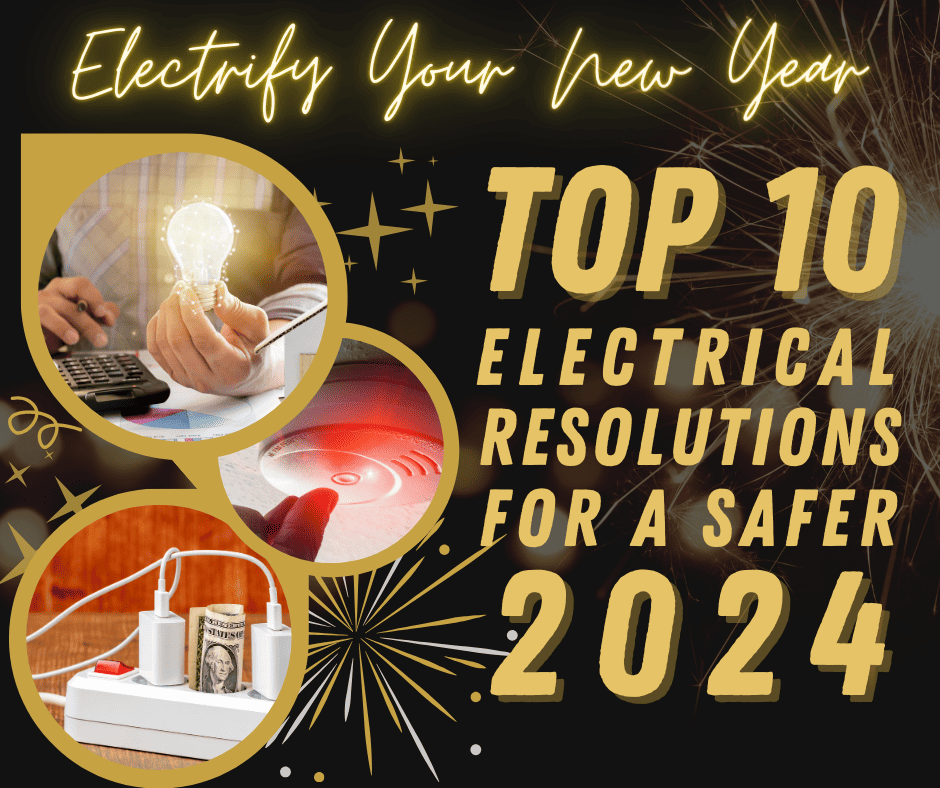Electrify Your New Year: Top 10 Electrical Resolutions for a Safer 2024

As we welcome the New Year, it’s the perfect time to make resolutions that not only improve our lives but also protect our homes. This year, let’s focus on electrical safety and efficiency. Here are ten electrical New Year’s resolutions to help keep your home safe and your energy bills down.
1. Commit to an Energy-Efficient Electrical System
Make your home safer and more energy-efficient this year. All electrical systems have the potential to cause shock, injury, fires, and death. According to the National Fire Protection Association, about 50,000 fires are caused by faulty electrical systems in homes each year, resulting in about 450 deaths and 1,500 injuries. Yet, too often, we take our electrical systems for granted and even overlook basic safety training not only for ourselves but our families as well. Let’s start with a professional inspection to ensure your wiring is up to the NEC standards.
2. Switch to Energy-efficient LED Bulbs
Embrace the brilliance of LED bulbs! Not only do they consume 75% less energy, but they also last 35 to 50 times longer than traditional bulbs. Plus, they offer more peace of mind since they emit very little heat, decreasing the threat of an electrical fire, and are much more durable, so they won’t shatter all over the floor.
3. Monthly Reset of GFCI Outlets
Commit to a monthly check of your Ground-Fault Circuit Interrupter (GFCI) outlets. You’ll find these outlets in moisture-prone areas such as the kitchen, bathroom, laundry room and any other areas where electricity and water might come into contact. Simply press the test/reset button and make sure the outlets trip and reset accordingly. If they are malfunctioning, call Hual Electric to have them replaced to reduced electrocution risk. If you don’t already have GFCI outlets in these critical areas, make sure to put this on the list of New Year resolutions.
4. Replace Smoke Detector Batteries
Ensure your smoke and carbon monoxide detectors have fresh batteries and test them monthly. Batteries in these detectors should be replaced annually, and the units themselves should be tested each month without fail. Smoke detectors have a service life of 10 years, after which they must be replaced. Carbon monoxide detectors vary, with older models typically requiring replacement every three years and newer models every five to six years. The U.S. Consumer Product Safety Commission (CPSC) estimated approximately 346,800 residential fires in 2019, leading to 2,490 fatalities, 11,760 injuries, and property damage amounting to $7.38 billion. Carbon monoxide, often dubbed the ‘invisible killer’, is odorless and colorless, and can emanate from everyday appliances like portable generators and heating systems.
5. Install a Whole-House Surge Protector
Lightning and power surges are no joke in our area! Your electrical appliances and devices can be slowly compromised due to these surges, affecting both operation and life expectancy. Plus, power surges have the potential to cause sparks that can lead to a fire. This new year, why not think about installing a whole-house surge protector to reduce damage. Protect your home and appliances from unexpected power surges with a whole-house surge protector. This device is essential for maintaining the longevity of your appliances and preventing fire risks associated with power surges.
6. Say Goodbye to Extension Cords
We’ve all been guilty of this faux pas. An extension cord can be particularly useful when you need to relocate an item, such as a lamp, from one room to another. However, it’s important to make sure you don’t overlook the safety hazard an extension cord can place on your home. It’s vital you take the time to carefully place your extension cords out of the way and in a safe place. Reliance on extension cords can indicate a need for more outlets. Let’s resolve to use cords only temporarily and consider additional outlet installation for a permanent solution.
7. Upgrade Two-Prong Outlets
Why? Put simply, two-prong outlets are unsafe. Fact is, since 1962, code says all new houses must install three-prong outlets. They help protect your home against electrical shock, electrical fires and damage to your electronics and appliances.
Also think about installing tamper-resistant receptacles. These electrical outlet designs have spring-loaded shutters over the slots that won’t open unless pressure is applied to both at the same time. They need less oversight than child safety covers, which have to be unplugged before the outlet can be used.
8. Be Aware of Faulty Wiring
Stay vigilant for signs of faulty wiring, such as warm switches, tripping circuits, or flickering/dim lights. These can be symptoms of bigger issues that need immediate professional attention.
9. Smart Ceiling Fan Usage
Maximize your ceiling fans by adjusting their rotation with the seasons. Set your fans to spin clockwise in the winter and counter-clockwise in the summer. Adjusting their direction seasonally can aid your HVAC system and lead to energy savings.
10. Eliminate Energy Vampires
Unplug appliances when not in use to combat ‘vampire power.’ That’s the energy appliances draw when they’re just plugged in and not being used. It might not seem like much (after all, how much power could something as a countertop coffee maker use?). But when added up, it can become rather problematic. A study by the National Resource Defense Council found that homes lose around $165 per year on “vampire power” consumption. The most familiar sources of “vampire power”: TVs, computers and kitchen appliances. Unplug unused appliances or use power strips to turn off multiple devices at once, preventing unnecessary energy drain.
Warning: Make sure it’s safe to turn off the electricity before you start this project. You’d hate to face your daughter if you shut down her computer before she has the opportunity to save her 50-page report. Just sayin’.
